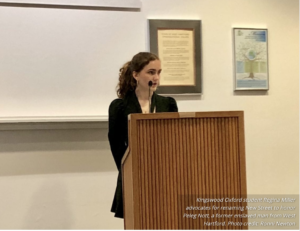West Hartford Town Council Approves Procedure for Honorary and Historic Renaming of Public Streets

By Sophie Christensen on We-Ha.com on June 9, 2021
In a January Letter to the Editor, Aliza Sadiq and Regina Miller (two Kingswood Oxford students) asked the West Hartford Town Council to rename New Street in Blue Back Square. They wish to honor Peleg Nott, who had been enslaved in West Hartford but according to research was an extraordinary man eventually elected to the honorable position of “Black governor.”
After their research for the Witness Stones Project, Aliza and Regina discovered shocking truths about the history of slavery in town. There were about “70 people enslaved in West Hartford alone, which is double the number we thought it was four years ago,” they said in the letter. Continue reading.
Tombo’s Story
By Huiying Muhs, Elisabeth C. Adams Middle School, ’21
Many people know about slaves and some know their names, but most people don’t think about their life stories because there is not a lot of information to tell. One of the slaves that we should know about is an African-American man named Tombo. Tombo went by many names throughout his lifetime each connecting to the stages of his life. He lived in North Guilford, which might seem impossible. The idea that if you walk past Melissa Jones Elementary School you may be walking on the path of a slave more than two-hundred years ago. Tombo -also known as Thomas Beau, Bow, or Bray- was enslaved by a man named Reverend Thomas Bray. But, the fact that he was a slave under this Reverend does not make up his whole identity.
Tombo’s enslaver, Reverend Thomas Bray, was a wealthier white man who participated in church and was viewed as gentle and cheerful. He lived for seventy years which is quite a long life-span during this time period. He was born on October 3, 1738 and spent his life becoming a minister of North Guilford Congregational Church. He was married two times to Sarah Robinson and Anna Bates of Durham and had a total of eleven children. He later died on April 23, 1808 having lived a long life. To him, owning Tombo was a small part of his life for it was the regular thing to do during his time, but to Tombo it is a different story.
Because Tombo was an African-American slave, many pieces of his life were not recorded such as his date of birth, death, when he was enslaved and when he was set free. This was because slaves were treated as less than humans. They were not worthy of needing to be recorded into history and this is also why while Tombo was a slave he had no last name. What we do know was while he was a slave, he was able to get baptised at his local church of North Guilford on October 18, 1772. Doing something as simple as getting baptised should have been a right that any person was given but many were not allowed it. So by doing so Tombo showed a sense of human agency, participating in an action that humanises him even in the slightest amount. He also married a woman named Pender and had a daughter named Nancy-Jetter who was also baptised. Sadly, Pender died before the age of fifty. We don’t know the exact age because owners and other people believed they were superior so they treated the slaves horribly and that was one of the many horrible things that Tombo had to endure. Much like other slaves he was treated as property. He was able to get remarried to a woman named Candace.
Candace was also a slave but was freed in January 18, 1793 when she was between the age range of twenty five and forty five by the descendants of her original enslavers due to the 1792 Act stating slaves can only be free if they are between the ages of twenty five and forty five and in good health. Tombo soon followed in Candace’s steps and also became free and lived in a house with two other people in the Nut Plains area who we can assume were his wife and child. Later in their lives they sold his father-in-law’s property on Nut Plains with his family of Moses, Pompey, Cesar, and Candace making a profit of $26.67; this shows the advancement they made in their lives to be able to show a level of agency by not just owning property but being able to sell and make a profit from land


